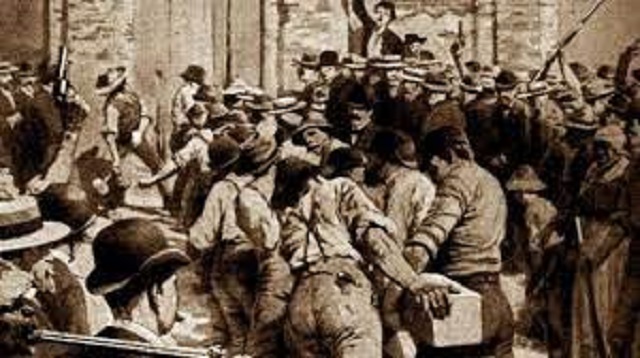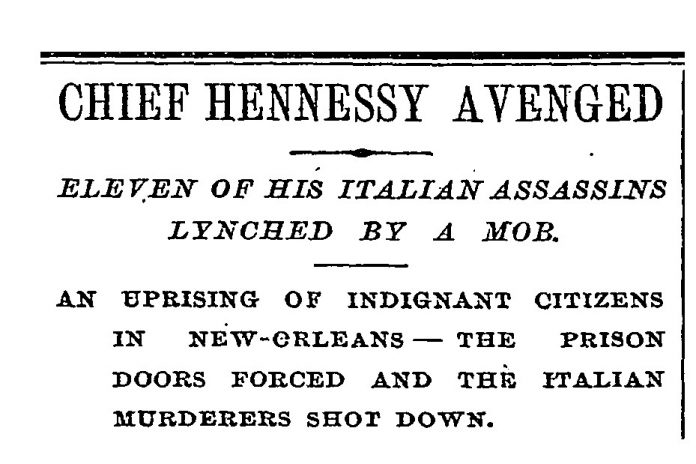By Joseph M. Calisi, ©2022 All Rights Reserved
April 1, 2022
On March 14, 1891, 11 Italians were lynched by a mob in New Orleans in reprisal for the killing of a local police chief, Commissioner David Hennessy, in his home on Oct. 15, 1890, by four men. They blamed the Italians. The mass killing is known as the most deadly lynching in US history and happened after Italian Immigrants were acquitted in court the day before. Eight of the 11 were US citizens.
At the time, there was already a significant growing level of sentiment against Italian businessmen that treated African-Americans fairly in their dealings as other locals thought the blacks should’ve been short-changed instead because of their ethnicity.
Out of 30,000 New Orleans residents that were Italian, 19 were rounded up, charged with the commissioner’s killing, and a trial was set for February 1891. The group was exonerated in court, which led to a “Vigilance Committee” calling for a “prepared for action” meeting according to a 1991 article in The Times-Picayune of New Orleans.
On the morning of March 14, 1891, a notice ran in a local newspaper calling for a gathering at the Henry Clay monument located just to the south and east of where Union Station stands today.
At 10 am, the mob that gathered was so voluminous that the streetcars could not operate.
Drunk with anger, they stormed the jail where the Italians were being held ‘for safety’ and the lynching occurred. One man was hung from a light pole and shot multiple times. Others while in jail, were stabbed and shot to death. The Italian government closed its consulate in the US in protest and demanded reparations. In response, the US government closed its consulate in Rome in a reciprocal action.
Eventually, only $25,000 was paid to the families of the deceased.
The 1891 New Orleans lynching was not the only one to occur as several dozen other Italians also met the same fate in north Louisiana and Colorado.
In 2019, Michael Santo of the Order Sons and Daughters of Italy in New Orleans, asked the city for an apology and Mayor LaToya Cantrell agreed, and an event was held later that month.
The leader of the Human Relations Commission, Vincenzo Pasquantonio, was named as the liaison for the event.
A proclamation was released on April 12 and presented in a ceremony at the American Italian Cultural Center in New Orleans.
New Orleans Mayor LaToya Cantrell, standing next to an Italian flag, issued a posthumous apology to eleven Italians and their descendants that were victims of a mass lynching in 1891. The solemn ceremony was held on April 12, 2019, at the American Italian Cultural Center on South Peters Street in the New Orleans Central Business District. Attendees traveled from around the country to witness the apology for what is considered the largest lynching in American history. Antonio Bagnetto, Antonio Marchesi, and Antonio Scaffidi; stevedores (aka longshoremen or dockworkers), James Caruso and Rocco Geraci; cobbler Pietro Monasterio; tinsmith Loreto Comitis; street vendor Emmanuele Polizzi; fruit importer Joseph P. Macheca; ward politician Frank Romero; and rice plantation laborer Charles Traina were murdered in New Orleans by a crazed lynch mob on March 14, 1891.
Published reports say that the Italians were hung, shot and/or beaten to death to avenge
the murder of Police Chief David Hennessy near his home on October 15, 1890. Chief Hennessy had developed a career-long pattern of what many believed falsely arresting and charging Italians and Italian Americans for crimes. He also had petulance for making ethnic slurs against Italians. At the time, there was a growing nationwide anti-Italian sentiment in the 1890s that directly contributed to the lynching of these men.
The day before the lynching, several of the Italians were cleared in court of killing the police chief while 4 of them hadn’t gotten to trial yet.
Angered by the ‘not guilty’ court decisions, a notice was posted in a local paper under the guise of organizing a ‘vigilance committees’ to rally lynch mobs at the old Orleans Parish Prison in such numbers the trolley cars were prevented from operating.
In the wake of the 1891 lynchings, Joseph Shakspeare, the mayor of New Orleans, was reported as displaying no remorse over the murders of the eleven Italians by the lynch
mob. In 1891, James Gill wrote an opinion in The Advocate of New Orleans that said:
“Was Shakspeare sorry? Not at all. In fact, the slaughter was largely his idea, and the pillars of local society, for whom Sicilian immigrants were the scum of the earth, made sure it was carried out.” Mr. Gill, also stated in the article that United States President Benjamin Harrison was not acting at the behest of New Orleans when, after a diplomatic standoff, the president authorized $25,000 in reparations in total to the families of the eleven lynched men.
On April 12, 2019, the New Orleans newspaper, The Advocate, quoted current Mayor LaToya Cantrell who said, “What happened to those 11 Italians was wrong, and the city owes them and their descendants a formal apology.
At this late date, we cannot give justice, but we can be intentional and deliberate about what we do going forward.” Her statement was the first time any apology has been issued regarding the mass lynching that happened 128 [now 131 years] years ago. Mayor Cantrell added “I ask you to continue to stand with me against anti-immigrant violence, against division, and to stand up for what I have coined a ‘city of yes. And for the idea that we have a responsibility …to be the kind of people that our children are not apologizing for 128 [now 131 years] years from now.”
Special counsel to the Order Sons and Daughters of Italy in America, which represents 26 million Italian-Americans, Michael A. Santo who resides in New York said, “We hope that
this serves as a building block and a platform for people to address past national tragedies and move forward.”
Now, this longstanding wound has begun to heal.
A book penned by Richard Gambino called Vengeance in the 1980s was subsequently used as the inspiration for a movie by the same name that detailed many of these events.







